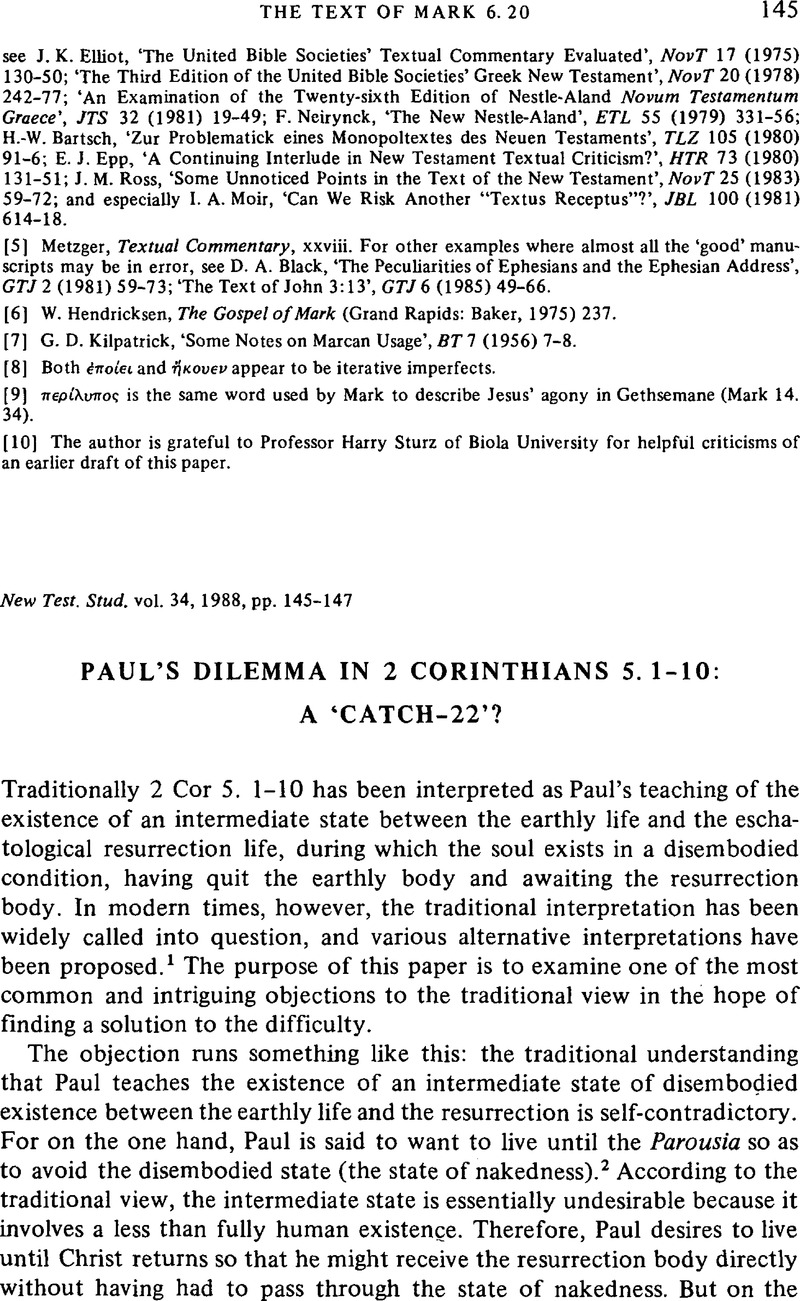Published online by Cambridge University Press: 05 February 2009

[1] For a survey of the various interpretations of this passage, see Friedrich Gustav Lang, 2 Korinther 5, 1–10 in der neueren Forschung, BGBE 16 (Tübingen: JCB Mohr, 1973).Google Scholar
[2] On nakedness as a description of a disembodied soul, see Plato, Cratylus 403B;Google ScholaridemGorgias 523, 524; idemPhaedo 67D, E; 81C; idemRepublic 9; 377B; Corpus hermeticum 1.26; cf. 9.18; Philo, De virtutibus 76;Google ScholaridemLegum allegoriae 2.57, 59; Lucian, Hermotimus 7.Google Scholar The normative view of first century Judaism was anthropological dualism including the continued existence of the disembodied soul after death. (Hoffmann, Paul, Die Toten in Christus, 3rd rev. ed., NTA 2 [Münster: Aschendorff, 1978] 26–174;Google ScholarGundry, Robert H., Sōma in Biblical Theology [Cambridge: Cambridge University Press, 1976] 87–93.)CrossRefGoogle Scholar See also Weiss, Johannes, Der erste Korintherbrief, 9th ed., KEKNT 5 (Göttingen: Vandenhoeck & Ruprecht, 1910) 370;Google ScholarPlummer, Alfred and Robertson, Archibald, First Epistle of Saint Paul to the Corinthians, 2nd ed., ICC (Edinburgh: T & T Clark, 1967) 147;Google ScholarSevenster, J. N., ‘Some Remarks on the γυμνός in II Cor V.3’, in Studia Paulina, ed. Sevenster, J. N. and Unnik, W. C. (Haarlem, Netherlands: Erven F. Bohn, 1953) 202–14;Google ScholarAllo, Ernst-Bernard, Seconde épître aux Corinthiens (Paris: Librairie Lecoffre, 1956) 121–2;Google ScholarGrass, Hans, Ostergeschehen und Osterberichte, 4th rev. ed. (Göttingen: Vandenhoeck & Ruprecht, 1970), 161;Google ScholarCullmann, Oscar, Immortality of the Soul or Resurrection from the Dead (London: Epworth Press, 1958) 52;Google ScholarHéring, Jean, Le second épître de Saint Paul aux Corinthiens, CNT 8 (Neuchatel, Switzerland: Delachaux & Niestle, 1958) 48–9;Google ScholarHughes, Paul, Paul's Second Epistle to the Corinthians, NLC (Edinburgh: Marshall, Morgan & Scott, 1962) 169–70;Google ScholarBarrett, C. K., A Commentary on the Second Epistle to the Corinthians, BNTC (London: Adam & Charles Black, 1973) 153–5.Google Scholar Hoffmann also finds confirmatory evidence for an intermediate state from the use of the terms αβυσσος (Rom 10. 7), έκ νεκρων (1 Cor 15. 12, 20), and παράδεισος (2 Cor 12. 1–4; cf. Lk 23. 43; Acts 2. 7). (Hoffmann, , Toten, 177–86.Google Scholar) But the decisive passage proving Paul's belief in such a state is Phil 2. 21–6. (Ibid., 286–320.)
[3] In this respect Paul differs from Jewish apocalyptic views of the intermediate state. Cf. 2 Baruch, 30. 2–5;Google Scholar 4 Ezra 7. 26–44; 1 Enoch 22. 1–14. See also Hoffmann, , Toten, 286–320.Google Scholar
[4] So named from Joseph Heller's novel Catch-22, in which the protagonist, a wartime pilot flying dangerous bombing missions over Italy, hopes to orchestrate his dismissal from service by convincing his commanding officer that he is insane. But the catch is that in order to be dismissed for insanity, one has to request dismissal, and a request for dismissal reveals that one is sane after all, since a concern for one's safety in the face of immediate danger betrays the processes of a rational mind. So the only way to show oneself to be insane is to keep on flying the suicidal missions, which is precisely what he wanted most to avoid!